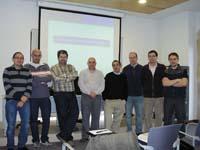Networked climate data over the past 40 years

In fact, the world model studies land with a distance of one hundred kilometers, that is, the smallest area of study has an area of ten thousand square kilometers. The wind group is developing a small-scale model. Based on the large-scale model, they have reduced the study area. The smallest study area has an area of 225 square kilometers. This requires, logically, a greater amount of data, but provides better and more accurate information.
To carry out this work, they take the necessary data from the database formed by the European Center for Medium Term Weather Predictions (ECMWF). This data bank collects data obtained at all climate observatories around the world.
By gathering all the data and developing the small-scale model, they can collect concrete climate data from the last 40 years. Initially, the work was limited to the Gulf of Bizkaia, and today the model has extended to the western area of Europe.
Model Specifications
The model consists of a square grid. Each square occupies an area of 15x15 kilometers and the reference points are the vertices of the paintings. Thus, for example, in the case of the Iberian Peninsula more than 2,500 reference points are obtained --the large-scale model brings about 30 points.
At the beginning of the research, the Eolo group was based on large-scale models. This model provides information at a reduced scale, but the pictures on your network are much larger and contain no information within the small model network. Therefore, it provides this data by simulation. However, by simulation, some small-scale phenomena are not properly described.

Analysis of past phenomena
The possibility of performing climate simulations in the last 40 years is very useful both to explain past phenomena and to predict what will come. In this way we can analyze the phenomena that have occurred around a certain past climate event. For example, knowing well the phenomena that occurred before the 1983 floods, it would be possible to foresee similar events in the future.
This study includes all data obtained with the model developed by the Eolo group in the ECMWF database to complete it. In addition, the objective of the Eolo group is to make all data available to all at the end of the research. Thus, both researchers and climate-related industries and activities will be able to use this information to choose the proper location of solar panels or wind turbines -- to be able to know the wind forces or the hours of sunshine in a given area, or for agricultural activities, for example.






